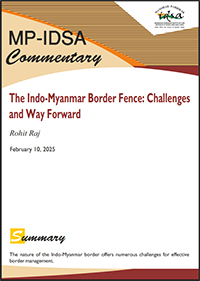The Indo-Myanmar Border Fence: Challenges and Way Forward
- February 10, 2025 |
- IDSA Comments
Introduction
The porous India–Myanmar border has been a cause of concern for peace, stability and economic development.[1] This region faces multiple issues, such as drug trafficking from Myanmar, the influx of insurgents and the illegal arms trade exacerbating the security situation in the Northeast. In a bid to address the above-mentioned challenges, the Ministry of Home Affairs (MHA) on 6 February 2024 announced plans to fence the entire 1,643 km long India–Myanmar border.[2] Further, to facilitate surveillance, a patrol track will also be paved along the border. According to MHA:
Out of the total border length, a 10 km stretch in Moreh-Manipur has already been fenced. Furthermore, two pilot projects of fencing through a Hybrid Surveillance System (HSS) are being carried out. A one kilometre stretch of each in Arunachal Pradesh and Manipur borders are under execution using virtual fencing or HSS.[3]
In order to strengthen security and preserve the demographic integrity of the northeastern states, on 8 February 2024, the Government of India (GoI) announced that the Free Movement Regime (FMR)[4] with Myanmar, in force since 1950, will be scrapped. The FMR has been considered responsible for facilitating the movement of illegal migrants and the flow of arms and drugs. According to this agreement, individuals could enter up to 16 kms into each other’s territory, with a stay limit of 72 hours in India and 24 hours in Myanmar. This initiative aims to minimise bureaucratic hurdles for tribal communities in the northeast, enabling them to visit relatives across the border with ease.[5]
While the FMR has not yet been scrapped, according to the new guidelines as noted by media reports in December 2024, its rules and regulations have been strengthened.[6] The range of free movement has been reduced to 10 kms from the earlier 16 kms. Assam Rifles (AR) will conduct proper document inspection followed by security and health check-ups by the State police and health department officials. The AR will upload all the documents on the Land Ports Authority of India portal under MHA after recording biometrics and issuing a border pass with a photograph and a QR code. The pass needs to be deposited while returning from the same crossing point before the completion of seven days.[7] On 18 September 2024, the Cabinet Committee on Security sanctioned Rs 31,000 crore to fence and develop a patrolling track along the 1,643-km-long India–Myanmar border.[8] There are, however, key obstacles in fencing the Indo-Myanmar border.
Challenges in Fencing the Border
Building a border fence along the international boundary demands favourable geography, local population support and adequate funds. Unfortunately, the Indo-Myanmar border area lacks the required conditions. First, the most unavoidable challenge is the difficult terrain of the region. The rugged terrain of the Himalayan Mountain range extends southward along the Indo-Myanmar border, into a fragmented chain of mountain ranges namely Patkai Bum, Naga Hills, Manipur Hills, Barail Hills and Mizo Hills. The average elevation of the mountain ranges reaches above 6,100 metres.[9]
High mountains, deep river channels and valleys characterise the borderland. Such challenging terrain hinders the development of transportation and communication infrastructure, leaving the border area sparsely populated and economically underdeveloped. The poor communication networks and lack of essential border infrastructure restricts the swift and efficient movement of border security forces along the border.
The humid subtropical climate of the region receives an average annual rainfall of 250 cm. This leads to dense forest cover across the Northeast region which creates a significant challenge in fence construction. The thick vegetation can overgrow over the border fences, necessitating frequent and intensive maintenance. Constant rainfall throughout the year provides very less favourable working months and could delay the completion of fence construction by various months.
Second, the cultural and socio-economic landscape of tribal communities is extensively spread along the border. Bordering states are mainly inhabited by tribal and ethnic groups such as Naga tribes in Nagaland, Kuki tribes in Manipur and the Mizo and Chin tribes in Mizoram.[10] There are tribes like Konyak, Tangkhul, Khiamniungan, etc., who reside on both sides of the border. They share their tradition, culture and resources with their kith and kin living on both sides of the border. So, the tribal groups along border areas may create resistance to the government in fencing the border.[11]
Third, the support of the ruling political party at the state level and the support of the local population plays a crucial role in the successful implementation of border fencing. As issues relating to land fall under the jurisdiction of the state government in India, opposition from the state government could create significant challenges in land acquisition. Currently, the Nagaland and Mizoram government are not in favour of border fencing along with the revocation of FMR. The Mizoram state assembly in March 2024 passed a resolution to oppose the government’s decisions on the Indo-Myanmar border.[12] Without gaining state government support, it could adversely impact the Indo-Myanmar border fencing initiative. The fencing authorities may face challenges in acquiring land for border fencing and the construction of Integrated Check Posts (ICPs). Among northeast states, Assam, Arunachal Pradesh and Manipur have expressed support towards the Centre’s decision, arguing that such measures are essential for the well-being and prosperity of the bordering states with Myanmar.[13]
Way Forward
The Indo-Myanmar border presents a significant security challenge to India’s internal security from the East, making border fencing an urgent necessity to ensure the safety and stability of the Northeast region. The nature of the Indo-Myanmar border offers numerous challenges for effective border management. As geography is an unavoidable challenge for fencing in certain areas, the Hybrid Surveillance System can be employed by using multiple types of surveillance technologies like video cameras, radar sensors, fibre optic sensors and thermal imaging, to monitor border perimeter effectively in such areas where the terrain is inhospitable to fence and patrol along the border. Secondly, imposing strict border controls may disrupt the social and economic fabric of tribal communities, leading to tensions and resistance. So, gaining local civilian confidence and support through consultations and incorporating their point of view can mitigate potential resistance from the tribal groups while fencing the Indo-Myanmar border. Such cooperative measures can enhance fencing efforts by multiple times. Last but not the least, ensuring a comprehensive and coordinated approach with the consent of each bordering state is crucial to maintaining a stable and peaceful Northeast. As the region faces diverse challenges, the issue of border management through fencing demands careful planning and execution.
Views expressed are of the author and do not necessarily reflect the views of the Manohar Parrikar IDSA or of the Government of India.
[1] Narender Kumar, “Border Management with Myanmar: A Strategic Imperative”, Centre for Land Warfare Studies, September 2014.
[2] “Modi Government is Committed to Building Impenetrable Borders”, Press Information Bureau, Ministry of Home Affairs, Government of India, 6 February 2024.
[3] “Union Home Minister and Minister of Cooperation, Shri Amit Shah Says Modi Government is Committed to Building Impenetrable Borders”, Press Information Bureau, Ministry of Home Affairs, Government of India, 6 February 2024.
[4] “MHA Decides to Scrap Free Movement Regime (FMR) Between India and Myanmar”, Press Information Bureau, Ministry of Home Affairs, Government of India, 8 February 2024.
[5] Pushpita Das, “Free Movement Regime: A Unique Feature of the India-Myanmar Border”, Comment, Manohar Parrikar Institute for Defence Studies and Analyses (MP-IDSA), 17 January 2024.
[6] Vijaita Singh, “Centre Yet to Formally Scrap Free Movement Regime with Myanmar”, The Hindu, 26 December 2024.
[7] Vijaita Singh, “Demographic Data to Stop Influx Along Myanmar, Says Ministry of Home Affairs”, The Hindu, 30 December 2024.
[8] “Government Sanctions ₹31,000 Crore to Fence Myanmar Border”, The Hindu, 18 September 2024.
[9] “An Astronaut’s View of the Himalayas”, NASA Earth Observatory, 11 December 2017.
[10] Narender Kumar, “Border Management with Myanmar: A Strategic Imperative”, no. 1.
[11] Alice Yhoshü, “Now, Nagaland Opposes Fencing of India’s Border with Myanmar”, Hindustan Times, 2 March 2024.
[12] Ophelia Yumlembam, “Indo-Myanmar Border Fencing Initiative: Assessing Imperatives and Challenges”, Observer Research Foundation, 18 May 2024.
[13] Ibid.





